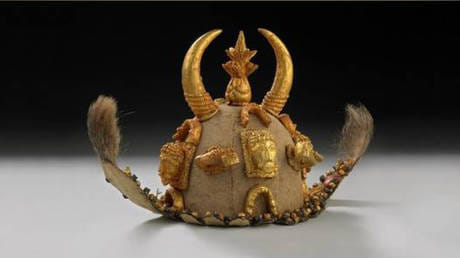
British generosity: The UK is loaning back African gold it stole. Is it the best it can do?
British generosity: The UK is loaning back African gold it stole. Is it the best it can do?
How did crown jewels from Ghana end up in London, and is there any way to bring them back home?
At the end of January, the British Museum and Victoria & Albert (V&A) Museum announced that more than 30 Asante ‘crown jewels’, gold artifacts that once belonged to the royals of Asante (or Ashanti) in modern-day Ghana, would be brought to the Ghanaian city of Kumasi in April.
This, however, is only a loan deal between the UK museums and the Ghanaian Manhyia Palace Museum. British laws ban museums from permanently returning contested artifacts to their original owners, which means that despite the announced ‘repatriation’, the golden items, illegally extracted some 150 years ago, will only be temporarily placed in Ghana. Will they ever be returned for good?
Historical artifacts aptly depict the culture of a people. Given the waning influence of African traditional institutions, largely eroded by Westernization and cultural importation, societal narratives find resonance when historical events and souvenirs are relied upon. When discussing the legacy of culture, tracing back to a time of overpowering community influence on legal, religious, and nuptial relationships, these artifacts lend credence to the veracity of handed-down stories.
Despite fluctuations in the gold trade over the years, Africa’s role as a significant player in the gold market is firmly established. In 2022, a cohort consisting of Switzerland, the UK, US, Hong Kong, and the United Arab Emirates accounted for about 60.6% of global gold sales. However, Africa still holds over 40% of the world’s gold reserves. This reality underscores the enduring importance of the continent in the gold industry.
Central to this narrative is the story of the Ashanti Gold. The Ashanti region, formerly known as Asante, holds historical significance for its involvement in the trans-Atlantic slave trade during the 19th century. Despite this dark past, it was also renowned for its exquisite gold and brass craftsmanship, as well as its production of Kente, a brightly colored woven cloth. These contributions to the global trade market earned the region, which later became part of Ghana, the moniker ‘Gold Coast’.
It was an easily targeted spot for slave traders and gold grabbers who covertly masqueraded as traders. Therefore, it features prominently in the African historical narrative of capital and human exploitation by Europeans. Dr. Judith Spicksley, a historian at the Wilberforce Institute for the Study of Slavery and Emancipation (WISE) at the University of Hull, in her seminal article ‘Pawns on the Gold Coast’, describes how early in the trade relationship, Europeans took gold pawns as security for debt. However, as unorthodox rules for slave operations weakened and the lust for more gold overshadowed the emergent supply, Europeans turned increasingly toward the use of human pawns. This is no different from other exploitative processes that led to the loss of precious resources on the continent.